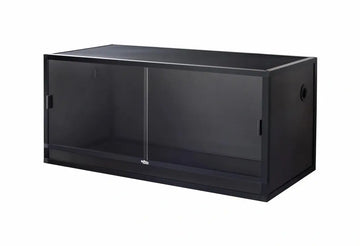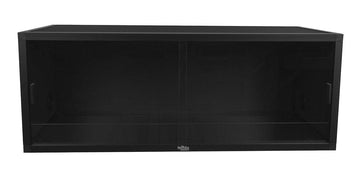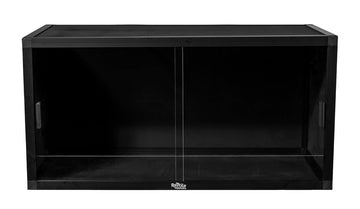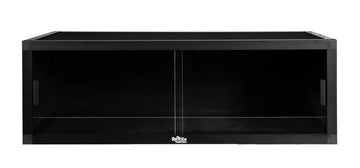Sulcata tortoises (Centrochelys sulcata) are a 24-30” long species of tortoise native to sub-saharan Africa. Their preferred habitat is semiarid grassland, savanna, and shrubland.
Sulcata tortoises generally have a light tan to light brown-colored shell with scutes that are outlined with a darker color. The shell is gently domed. The forelegs feature large, thorn-like scales and the hind legs have horn-like scales on each thigh.
Sulcata tortoises are very common in the US pet trade, but their enormous size makes them demanding pets that generally can’t be adequately kept indoors. However, when kept correctly, they have gentle, curious dispositions and can live over 70 years!
Enclosure size for sulcata tortoises
Sulcata tortoises have different needs based on their age.
Young sulcatas can be kept indoors. We recommend a 4’L x 2’W or larger enclosure for the first few years of their life.
Older, larger sulcatas really should be housed in outdoor pens. We suggest at least 50’L x 50’W, with a 2’ high wall that also extends at least 2’ underground. The border wall should be made of sturdy, opaque material such as concrete, cinder block, or brick to discourage pacing and escape attempts.
Cohabitation (housing multiple animals in one enclosure) is not really recommended with sulcata tortoises. Males are very territorial. Due to the already oversaturated population, we strongly recommend avoiding breeding.
Do sulcata tortoises need UVB?
Yes, sulcata tortoises require exposure to UVB in order to maintain good health.
Sulcatas housed outdoors do not need artificial UVB lighting, as they get all the UVB they need from exposure to sunlight.
Sulcatas housed indoors do need UVB lighting. The best UVB bulbs for sulcata tortoises are:
- Arcadia T5 HO 12%
- Zoo Med T5 HO Reptisun 10.0
If the bulb is mounted in a Zoo Med Reptisun T5 HO Terrarium Hood fixture without mesh obstruction, it should be placed 9-12” above the top of the tortoise’s shell in the basking area. Bulbs mounted in the Arcadia ProT5 fixture can be placed further away: 14-16” above the tortoise’s shell.
Your UVB bulb and fixture should be roughly half the length of the tortoise’s enclosure. Most people do a 12 hour on and 12 hour off schedule, but you can also choose a schedule that follows the sun. So, more light in the summer and less light in the winter. However, if your tortoise is housed outdoors and has access to sunlight, you will not need a UVB lamp.
Since sulcata tortoises have such large enclosures, we recommend more illumination than just a UVB bulb for indoor enclosure. You can use a 6500K LED or T5 HO fluorescent grow light for this purpose.
Best temperature for sulcata tortoises
Sulcata tortoises housed outdoors do well with average daily temperatures of 80-105°F during most of the year. Part of the enclosure should be shaded to offer a cooler area. Night temps can drop down to 60°F without needed extra heating, but it’s a good idea to provide a tortoise “house” inside the enclosure maintained at 60-70°F.
For younger sulcata tortoises housed indoors, we suggest at least one halogen flood heat bulb to create a basking temperature of 100-105°F. You can measure basking and surface temperatures with a temperature gun. Ambient temperatures can be between 80-90°F. We recommend nighttime temperatures to be maintained around 70-75°F. We suggest measuring these ambient temperatures with a digital probe thermometer.
We recommend the fixtures/bulbs be at least 8” away from the top of your tortoise’s shell. If the bulbs are too intense, you can purchase a rheostat or dimmer to control the intensity. Do not use ceramic heat emitters (CHEs), red bulbs, or blue bulbs, as these are not as effective.
Best humidity levels for sulcata tortoises
Sulcatas are native to a more arid region, but they do need more humidity than you would expect, especially when they are young!
For sulcatas housed outdoors, the most important thing is to make sure that the enclosure is not perpetually moist or wet. Rainfall should be relatively infrequent. Providing a mud-hole as part of the enclosure can be helpful in dry climates.
For sulcatas housed indoors, aim for about 80%. We also recommend providing a humid hide on the cool side, lined with moistened sphagnum moss. Humidity can be monitored via digital probe hygrometer, with the probe placed in the middle of the enclosure.
Best substrate for sulcata tortoises
Sulcata tortoises do well with a substrate/bedding that replicates their natural habitat and provides something for them to dig in as desired. For sulcatas housed outdoors, what you already have in your yard/pasture should be fine. However, if you have perpetually moist soil, then you can excavate the soil at least 2’ down and replace it with layers of stone paver, gravel, and sandy soil.
For sulcatas housed indoors, we recommend the following substrates:
- Zoo Med ReptiSand
- Exo Terra Desert Sand
Plain topsoil mixed 60/40 with play sand also works well. It should be at least 6” deep and completely replaced every 6 months. Remove poop and urine daily, along with all contaminated substrate.
You can also use a thick layer of clean timothy, Bermuda, orchard grass, or similar hay for indoor substrate. This must be completely replaced daily to avoid molding.
How to decorate a sulcata tortoise enclosure
An empty terrarium makes for a bored tortoise, reducing its quality of life. Keep your pet entertained and engaged with its environment with the strategic use of décor items that encourage it to exercise natural behaviors!
Here are some ideas to get you started:
- additional hiding places/burrows
- logs
- live, edible plants
- large, flat stones
The more stuff you add, the more functional your enclosure is likely to become! As an additional feature, you can shape the substrate into hills to create more environmental variety for your pet.
For outdoor enclosures, we recommend planting a variety of drought-tolerant, edible weeds and grasses for the tortoise to graze on.
What to feed to a sulcata tortoises
Sulcata tortoises are herbivores, which means that they need a high-fiber, plant-based diet to stay healthy. Variety is key to good nutrition, but your tortoise’s diet should still be about 90% grasses and weeds, and about 10% “salad” greens and vegetables. Flowers can be used as treats. We do not recommend feeding fruits.
Safe grasses/leaves for sulcata tortoises: lawn grass, mulberry leaves, grape leaves, hibiscus leaves, meadow hay, oat hay, orchard hay, timothy, clover, dandelions, nasturtium, geranium, coreopsis
Safe greens and vegetables for sulcata tortoises: cactus pads, kale, collard greens, endive, chicory, escarole, mustard greens, green/red leaf lettuce, turnip greens, romaine lettuce, spring mix, pumpkin, and squash.
Edible flowers like nasturtium, daisy, dandelions, geranium, roses, petunia, and hibiscus are great to add for variety and extra vitamins.
Offer food every day on a plate or tray to prevent substrate ingestion. Sulcata tortoises have enormous appetites, so plan accordingly! Note, however, that young sulcatas do not have very strong jaws, and will struggle with dried grasses. You can add some water to dried grasses and they may eat it like that.
Supplements
You will also want calcium and vitamin supplements to prevent your tortoise from developing a potential deficiency. We recommend Repashy Superveggie, lightly dusted on each meal. A little bit of Mazuri tortoise diet or Zoo Med Natural Grassland Tortoise Food also makes a nutritious addition. We also recommend keeping a cuttlebone in the enclosure. This provides a good course of calcium, but also helps keep their beak trimmed.
Water
Of course, don’t forget a water bowl! For drinking water, offer a shallow dish that is too small for them to soak in. Soaking is important to keeping your tortoise hydrated, so adults should be soaked in shallow, barely-warm water 1-2x/week for 15-30 minutes. Hatchlings and juveniles should be soaked every day.
Change the drinking water daily and scrub the dish weekly with a reptile-safe disinfectant, or whenever it becomes soiled.
How to handle your sulcata tortoise
Tortoises in general don’t like being handled, and this is nearly impossible with an adult sulcata, as they’re very heavy! However, if you want to interact with your tortoise, try hand-feeding or giving it light rubs on the head or shell.
*This care sheet contains only very basic information. Although it’s a good introduction, please further your research with high-quality sources. The more you know, the better you will be able to care for your pet!











